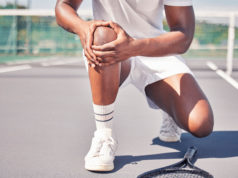By Page Love, MS, RDN, CSSD, LD, USPTA
If you caught our last issue (Jul/Aug 2020), I shared some beginning nutrition tips to combat COVID virus infection. As we learn more, we thought it would be important to update you on some food-related recommendations as you are returning to play.
As many of you know, the regular host team food hors d‘oeuvre table is not recommended, but the following CDC guidelines may be helpful for you, read more at cdc.gov, and at the American College of Cardiology’s site, acc.org.
Below is a summary of key health expert recommendations from above sources related to eating at tennis matches:
- There is no evidence that COVID-19 is spread by food. However, players sharing utensils and congregating around food and beverage areas can pose a risk.
- Clean and disinfect frequently touched surfaces such as team tables.
- Provide physical guides, such as tape on floors or sidewalks and signs on walls, to ensure that individuals remain at least 6 feet apart when waiting in line to order or pick up.
- If you plan to have any food available, consider having single serve grab-and-go options.
- Always wash your hands before eating, especially if eating finger foods. Carry hand sanitizer or antimicrobial hand wipes with you, or if you are a team captain, you may want to bring these for the team table.
- Use disposable food service items, including plastic utensils and dishes.
- Avoid offering any self-serve food or drink options, such as buffets, salad bars, and drink stations. Consider having pre-packaged boxes or bags for each player.
- Discourage people from sharing items that are difficult to clean, sanitize, or disinfect, such as a serving spoons.
- Limit any sharing of food; it is no longer recommended to bring large sharing dishes such as dips, fruit salad, casseroles, and chili.
- Wash hands before taking food from a general serving area, as well as before you eat.
- Bring your own towels and water bottles, as well as sport beverages for your matches.
- Do not share food, beverages or towels.
- Avoid communal faucets, water fountains, coolers and serving yourself ice from a group cooler.
- Avoid areas with high traffic or exposure to sweat.
- Frequently clean your counters and surfaces with commercial cleaning products. You can also make your own disinfecting solution by combining 5 Tbsp. of bleach or 1/3 cup liquid bleach with 1 gallon of water. After applying, let cleaning agents sit for 1 minute before wiping off. Make sure to rinse surfaces with water before putting food products on that. Team captains could wipe off surfaces such as picnic tables and court benches.
Additional considerations: Many clubs and facilities have stopped serving food and beverage as well. Teams may need to bring their own individual waters, snacks, and sport foods. Team captains should encourage their individual team members to bring prepackaged snacks. Healthier options include pretzels, jerky, humus, and low-calorie crackers.
Other on-court nutrition options could include bagels, rice cakes, or energy bars (for carbs), yogurt, string cheese or hard-boiled eggs (for protein), and water, sports drinks or tomato juice (for hydration).
A few more reminders for general sport nutrition to keep your immune system strong as we move into the colder time of year and flu season:
- Consume more colorful raw vegetables, especially deep green, red, orange-colored fall vegetables like spinach, squash, carrots, and pumpkin and wash your vegetables with water not sanitizing agents!
- Overcooking vegetables can decrease their vitamin and mineral contents. Try dipping raw vegetables in light ranch or dipping in peanut butter, or just enjoy the vegetable as is. These are also a great pre-tennis snack!
- Continue to hydrate well, you lose more water in cold weather sweating and need more water when you have a fever.
- Water is mandatory for proper metabolism and deliverance of nutrients to cells. Also, extra sweating makes adequate hydration even more important, as it can prevent cramps, dizziness, and general fatigue.
- Increase Vitamin D3 New research shows to reduce the risk of infection, it is recommended that people at risk of influenza and/or COVID-19 consider taking higher levels of vitamin D3 for a few weeks to rapidly raise 25(OH)D concentrations, followed by higher maintenance doses such as 5000 IU. The goal should be to raise 25(OH)D blood concentrations above 40–60 ng/mL (100–150 nmol/L). For treatment of people who become infected with COVID-19, higher vitamin D3 doses might be useful. (Nutrients 2020, 12, 988; doi:10.3390/nu12040988)
Page Love, MS, RDN, CSSD, USPTA is on the USTA Sport Science Committee and is a nutrition consultant to both the ATP and WTA professional tennis tours. She runs a private practice in Sandy Springs and Buckhead, and can be reached at nutrifitga.com.




